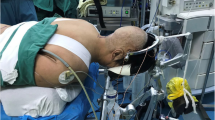Abstract
Introduction
This study aimed to highlight that atlantoaxial rotatory fixation (AARF) can be related to neurosurgery procedures in children, with an afterward demonstration of good results after halo-gravity traction and C1–C2 stabilization using the Harms technique.
Case description
To the best of our knowledge, this is the first case to report a 4-year-old boy who presented with AARF after a posterior fossa craniotomy to treat a cerebellar astrocytoma. At our medical facility, AARF was diagnosed using plain radiography and computed tomography imaging. The patient was treated with continuous cranial traction for 14 days. Initially, we detected that the patient had no C1 posterior arch or C2 spinous process; therefore, the best option was to perform the Harms technique. Postoperatively, the patient was placed in a cervical collar for 4 weeks. At the 4-year postoperative follow-up, the patient was doing well and had not developed any complications.
Conclusion
Herein, we report a case in which AARF can be developed after neurosurgical procedure. Surgical techniques used for atlantoaxial subluxation should be carefully selected. In our case, the Harms technique after cranial traction was an excellent option for correcting and stabilizing the abnormal neck position. However, further studies are required to determine the best technique to use in the pediatric population.




Similar content being viewed by others
Data availability
Not applicable.
Materials availability
Not applicable.
References
Fielding J, Hawkins R (1977) Atlanto-axial rotatory fixation. (Fixed rotatory subluxation: JBJS. J Bone Joint Surg 59:37–44
Tauchi R, Imagama S, Ito Z et al (2014) Atlantoaxial rotatory fixation in a child after bilateral otoplastic surgery. Eur J Orthop Surg Traumatol : Orthop Traumatol 24 Suppl 1. https://doi.org/10.1007/S00590-013-1254-6
Pang D, Li V (2004) Atlantoaxial rotatory fixation: part 1–biomechanics of normal rotation at the atlantoaxial joint in children. Neurosurgery 55:614–625. https://doi.org/10.1227/01.NEU.0000134386.31806.A6
Kelly EJ, Herbert KJ, Crotty EJ, O’Connor TPF (1998) Atlantoaxial subluxation after otoplasty. Plast Reconstr Surg 102:543–544. https://doi.org/10.1097/00006534-199808000-00040
Meza Escobar L, Osterhoff G, Ossendorf C et al (2012) Traumatic atlantoaxial rotatory subluxation in an adolescent: a case report. J Med Case Rep 6. https://doi.org/10.1186/1752-1947-6-27
Deichmueller CMC, Welkoborsky HJ (2010) Grisel’s syndrome–a rare complication following “small” operations and infections in the ENT region. Eur Arch Otorhinolaryngol 267:1467–1473. https://doi.org/10.1007/S00405-010-1241-Z
Don S (2004) Radiosensitivity of children: potential for overexposure in CR and DR and magnitude of doses in ordinary radiographic examinations. Pediatr Radiol 34 Suppl 3. https://doi.org/10.1007/S00247-004-1266-9
Pang D, Li V (2005) Atlantoaxial rotatory fixation: part 3-a prospective study of the clinical manifestation, diagnosis, management, and outcome of children with alantoaxial rotatory fixation. Neurosurgery 57:954–971. https://doi.org/10.1227/01.NEU.0000180052.81699.81
Ahmed R, Traynelis VC, Menezes AH (2008) Fusions at the craniovertebral junction. Childs Nerv Syst 24:1209–1224. https://doi.org/10.1007/S00381-008-0607-7
Goel A, Laheri V (1994) Plate and screw fixation for atlanto-axial subluxation. Acta Neurochir (Wien) 129:47–53. https://doi.org/10.1007/BF01400872
Harms J, Melcher RP (2001) Posterior C1-C2 fusion with polyaxial screw and rod fixation. Spine (Phila Pa 1976) 26:2467–2471. https://doi.org/10.1097/00007632-200111150-00014
Author information
Authors and Affiliations
Contributions
Vinicius de Meldau Benites: Conceptualization, writing the original draft, data acquisition, editing, and reviewing. Marcos Devanir Silva da Costa: Review and editing. Sergio Cavalheiro: Supervision, review, and editing.
Corresponding author
Ethics declarations
Ethics approval and consent to participate
The study was approved by the Research Ethics Committee of the Universidade Federal de São Paulo, São Paulo, Brazil. Informed consent was obtained from all the guardians.
Consent for publication
Informed consent was obtained from the guardians for publication.
Conflict of interest
No competing interests to declare.
Additional information
Publisher's Note
Springer Nature remains neutral with regard to jurisdictional claims in published maps and institutional affiliations.
Rights and permissions
Springer Nature or its licensor (e.g. a society or other partner) holds exclusive rights to this article under a publishing agreement with the author(s) or other rightsholder(s); author self-archiving of the accepted manuscript version of this article is solely governed by the terms of such publishing agreement and applicable law.
About this article
Cite this article
de Meldau Benites, V., da Costa, M.D.S. & Cavalheiro, S. Posterior C1–C2 fusion for atlantoaxial rotatory fixation after posterior fossa craniotomy in a 4-year old: a case report. Childs Nerv Syst 39, 1647–1651 (2023). https://doi.org/10.1007/s00381-023-05862-y
Received:
Accepted:
Published:
Issue Date:
DOI: https://doi.org/10.1007/s00381-023-05862-y




